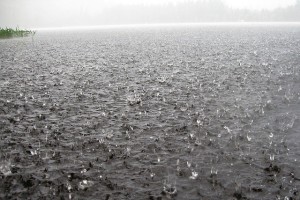by Carolyn Berndt
Extreme weather events, extreme drought and extreme flooding are among the impacts that climate change is and will have on water quality and availability in cities.
 According to the latest U.S. Drought Monitor Report, 30 percent of the contiguous United States is experiencing “moderate” to “exceptional” drought, with 82 percent of California experiencing “extreme” or “exceptional” drought. At the same time, cities up and down the east coast recently experienced higher tides than normal, known as “king tides,” due the alignment of the Earth, moon and sun.
According to the latest U.S. Drought Monitor Report, 30 percent of the contiguous United States is experiencing “moderate” to “exceptional” drought, with 82 percent of California experiencing “extreme” or “exceptional” drought. At the same time, cities up and down the east coast recently experienced higher tides than normal, known as “king tides,” due the alignment of the Earth, moon and sun.
While king tides are predictable events that are unrelated to climate change, the Washington Post described last week’s high water levels as a “preview [of the] the increasing threat of sea level rise” and called sea level rise an “X-Factor” that could exasperate the impacts of tidal flooding.
Earlier this year, the National Climate Assessment found that very heavy precipitation events have increased nationally, droughts have intensified, and flooding has increased in many parts of the U.S. The upcoming NLC Congress of Cities will dive into these topics through a two-part workshop for communities facing “too much water” and those facing “too little water.”
Too Much Water
Sea Level Rise
Approximately one third of the U.S. population—more than 100 million people—live in coastal communities that are threatened by rising sea levels and higher storm surges.
 Perhaps no group has been more vocal about drawing attention to the impacts of sea level rise on their community than local leaders in southeast Florida. In 2009, the counties of Broward, Miami-Dade, Monroe and Palm Beach formed the Southeast Florida Regional Climate Change Compact to jointly reduce carbon emissions and adapt to climate change, particularly sea level rise.
Perhaps no group has been more vocal about drawing attention to the impacts of sea level rise on their community than local leaders in southeast Florida. In 2009, the counties of Broward, Miami-Dade, Monroe and Palm Beach formed the Southeast Florida Regional Climate Change Compact to jointly reduce carbon emissions and adapt to climate change, particularly sea level rise.
Cindy Lerner, Mayor of Pinecrest, Florida will speak about the impacts of sea level rise on southeastern Florida and how local officials in the area are taking action to protect infrastructure, property and lives and raise awareness among citizens and the state government.
Heavy Downpours and Increased Flooding
With climate change and higher temperatures, extreme weather storms are arriving with greater frequency and intensity. Cities like Dubuque, Iowa face chronic and severe flooding as a result and are adopting solutions to managing an increasing amount of stormwater runoff. The Dubuque Bee Branch Watershed, where over 50 percent of residents live and work, is one of the areas hardest hit by flash flooding.
Roy Buol, Mayor of Dubuque will highlight the city’s efforts reduce stormwater and flooding, including the Bee Branch Watershed Flood Mitigation Project, which will reduce and slow the volume of stormwater through the watershed, provide a safe place for overflows, protect the city’s wastewater treatment plant, and expand upon and connect national and regional trail systems. Green infrastructure techniques, such as Dubuque’s green alley program, are becoming increasingly popular for communities as a means of managing and capturing stormwater and can also have added community and economic benefits.
 Too Little Water
Too Little Water
Hotter and drier are the themes for regions such as the Southwest and Great Plains, fostering increased wildfires and water scarcity. Extreme droughts are likely, as warmer temperatures result in melting and decreased snowpacks and depletion of groundwater and aquifers. Add in western water laws, and there is a recipe for real conflict over water resources. You’ll hear from Willits, California City Manager Adrienne Moore and Wichita Falls City Manager Darren Leiker on their cities’ efforts to conserve and reuse water and to adapt for the long-term reality in which water is a scarce commodity.
Colorado is a state of extremes. Karen Weitkunat, Mayor of Fort Collins will share the impact that the devastating 2012 High Park Fire had on water quality and how it served as a precursor for the extreme flooding that occurred the following year. She’ll share lessons learned from the two events and how communities are building back stronger, safer and more resilient.
Preparing Our Communities
Whether they are facing too little or too much water, communities cannot rely on past data to predict future needs. Climate change is introducing new challenges and risks for water quality and availability, and exasperating existing ones. Join NLC in Austin to dive deeper into these topics. Learn from experts about the impacts of climate change and how you can prepare and adapt to build a resilient community.


